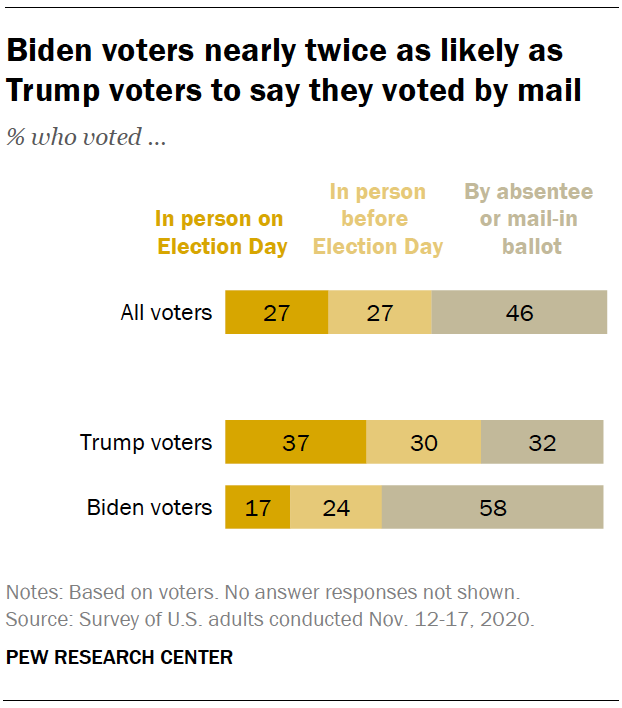
A slim majority of voters (54%) say they voted in person this November, compared with 46% who voted by absentee or mail-in ballot. About one-quarter (27%) report having voted in person on Election Day, and an identical share say they voted in person before Election Day.
Two-thirds of Trump voters say they voted in person, compared with 42% of Biden voters. Nearly four-in-ten Trump voters (37%) say they voted in person on Election Day, while just 17% of Biden voters say they cast their ballot at a polling place on Nov. 3.
Trump voters are also slightly more likely than Biden voters to say they voted in person before Election Day. Three-in-ten Trump voters report voting this way, compared with 24% of Biden voters.
Black voters were less likely to vote by absentee or mail-in ballot than white, Hispanic and Asian American voters. About four-in-ten Black voters (38%) say they voted by mail, compared with 45% of white voters, 51% of Hispanic voters and two-thirds of Asian American voters.
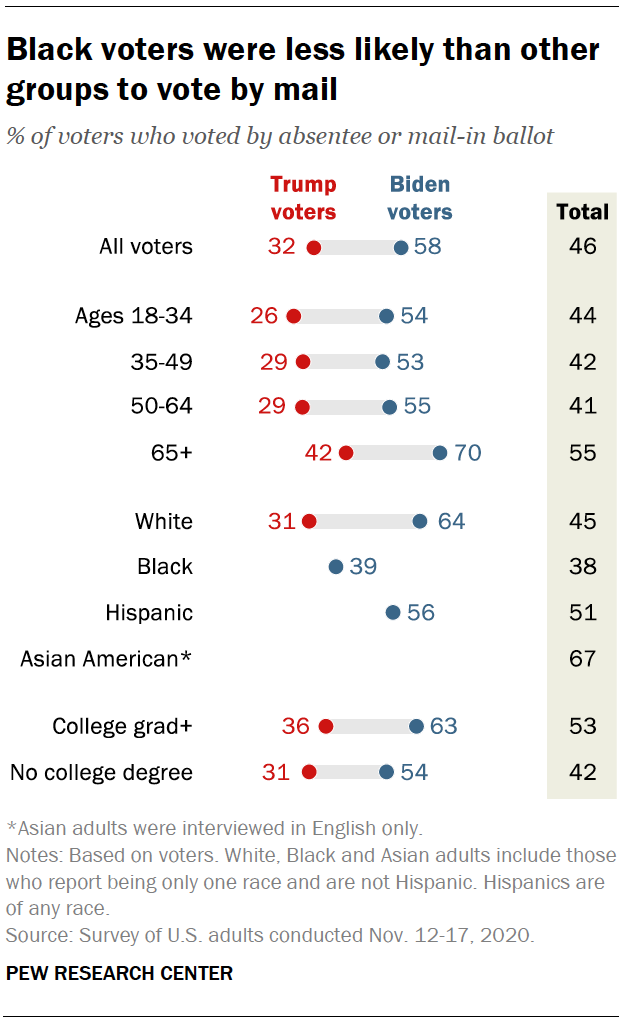
Among those who voted for Biden, these gaps are even larger. While 64% of White voters who supported Biden say they voted by absentee or mail-in ballot, smaller shares of Biden’s Hispanic supporters (56%) and Black supporters (39%) voted this way.
Voters ages 65 and older are more likely to say they voted by mail than younger voters. Similar shares of voters ages 18 to 34 (44%), 35 to 49 (42%) and 50 to 64 (41%) say they voted by mail. Among those 65 and older, a majority (55%) say they voted this way.
Within each age group, Biden voters are much more likely than Trump voters to say they voted by mail, with the size of this gap largely the same across groups.
College graduates are more likely than those without a college degree to say they voted by mail (53% vs. 42%).
Among absentee voters, Biden voters more likely than Trump voters to say they returned ballots early
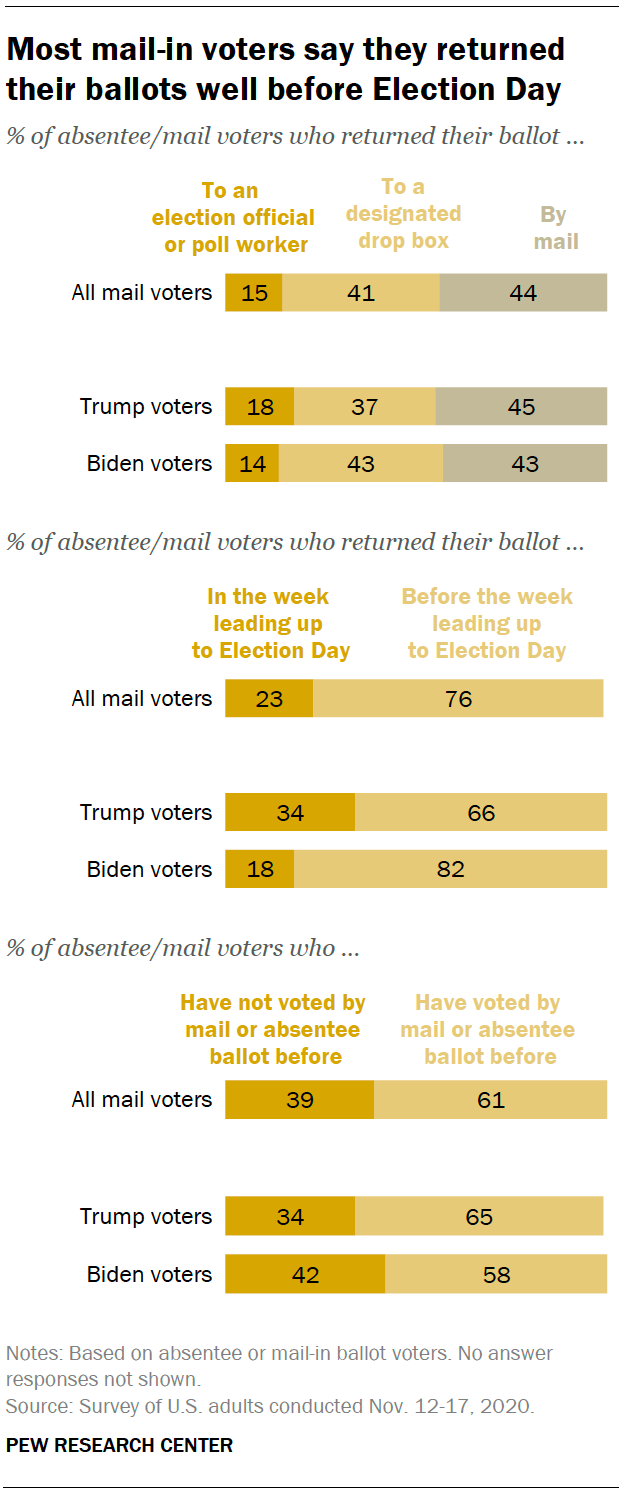
Those who voted by absentee or mail-in ballot were about equally likely to return their ballots to a designated drop box as they were to return their ballots by mail. About four-in-ten (41%) say they returned their ballots to a drop box, while 44% say they returned their ballots by mail; 15% say they returned their ballots in person to an election official or poll worker.
This pattern was largely the same among both Trump and Biden absentee voters.
Overall, about three-quarters of absentee or mail-in ballot voters (76%) report having returned their ballots at least a week before Election Day, while 23% say they returned their ballots in the final week leading up to Election Day. Biden voters were more likely than Trump voters to report having returned their absentee ballots in early: 82% of Biden voters who voted by absentee or mail ballot returned their ballots at least a week before Election Day, compared with 66% of Trump voters who voted this way.
Nearly four-in-ten absentee or mail voters (39%) say they had never voted by this method prior to this November’s election. Biden absentee or mail-in voters were slightly more likely than Trump absentee voters to report not having voted this way in the past (42% vs. 34%).
Nearly one-in-five in-person voters waited more than 30 minutes to vote
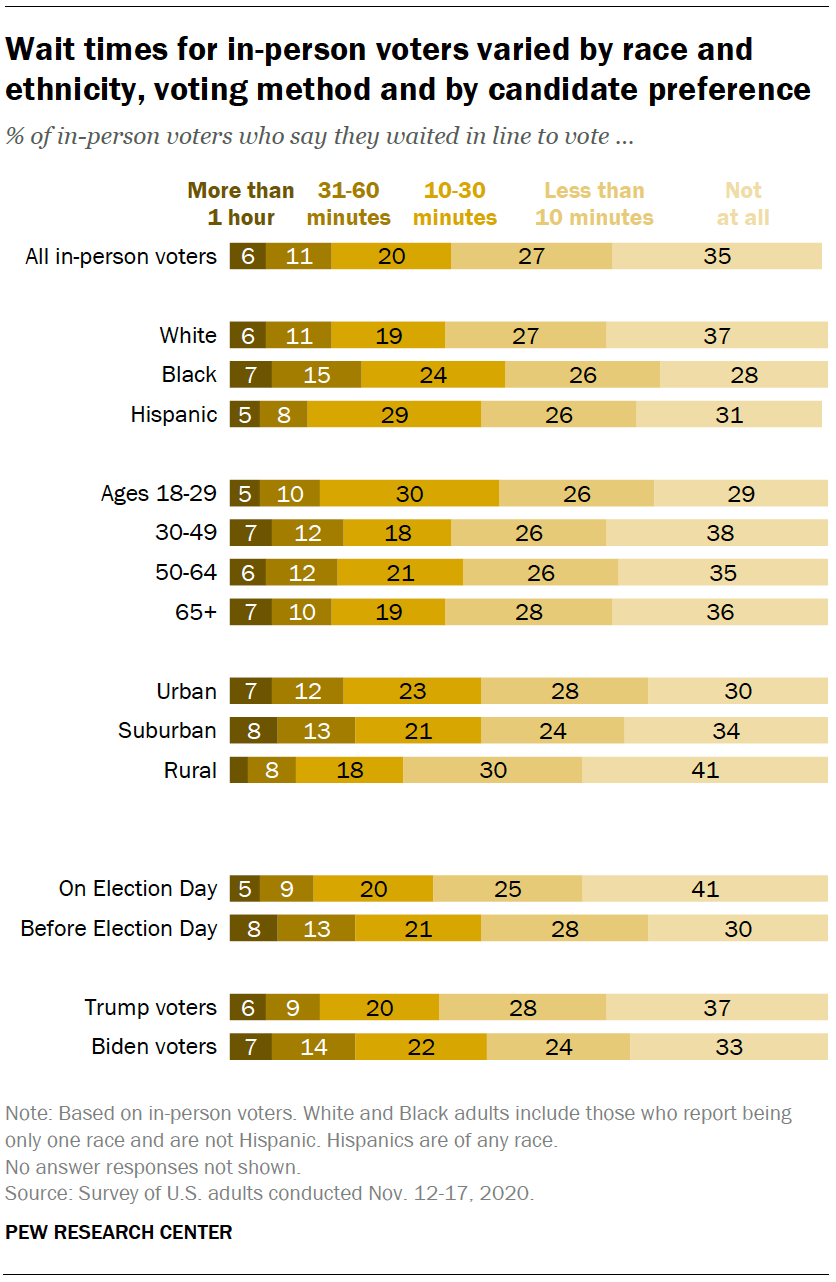
Among voters who voted in person in this election, 35% say they did not wait in line to vote at all. An additional 27% say they waited for less than 10 minutes. One-in-five waited for 10 to 30 minutes, 11% waited for 31 minutes to an hour, and 6% say they waited in line for more than an hour to vote.
Those who voted early waited longer than those who voted on Election Day: 21% of early in-person voters waited more than half an hour, compared with 14% of Election Day voters.
Black in-person voters also waited longer to vote than White or Hispanic in-person voters. Black voters are 5 percentage points slightly more likely than white voters to say they waited more than 30 minutes to vote and 9 points more likely than Hispanic voters to say this.
Those who voted for Biden waited longer to vote, on average, than those who voted for Trump. About two-in-ten in-person Biden voters (21%) waited more than half an hour to vote, compared with 15% of in-person Trump voters.
These differences are partly related to the longer wait times faced by those living in more densely populated areas. Voters living in rural areas were much less likely to face a wait of more than half an hour (11% of rural voters) than those living in urban (19%) or suburban (21%) areas.
Most voters say it was easy to vote in the election
More than nine-in-ten voters (94%) say that voting in the election this November was either very easy (77%) or somewhat easy (17%), while just 6% say that voting was very or somewhat difficult.
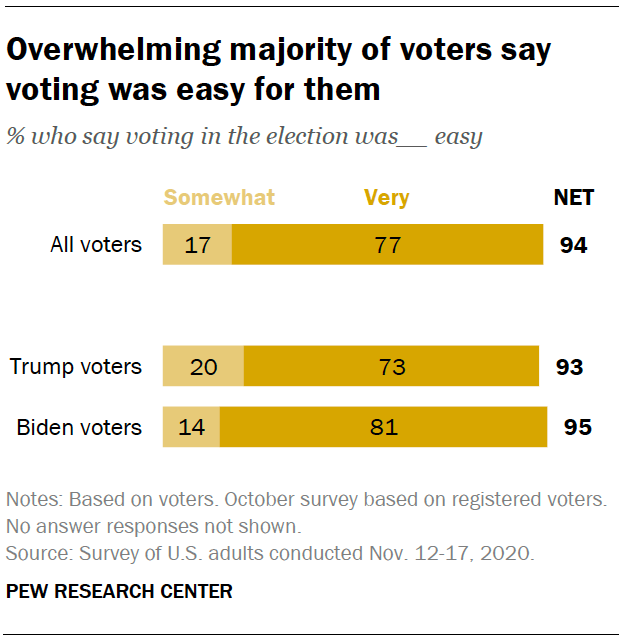
A month before the election, about a third of registered voters (35%) expected voting would be at least somewhat difficult, compared with 36% who expected it to be somewhat easy and 29% who expected it to be very easy.
Biden supporters had been somewhat more likely than Trump supporters to say they expected voting to be at least somewhat difficult in the preelection survey, with 38% of Biden supporters and three-in-ten Trump supporters saying this.
However, nearly identical shares of those who voted for Biden (95%) and those who voted for Trump (93%) now say that voting this November was easy. And Biden voters are now somewhat more likely than Trump voters to say that voting was very easy (81% vs. 73%).
In their own words: Why some voters faced difficulties casting ballots
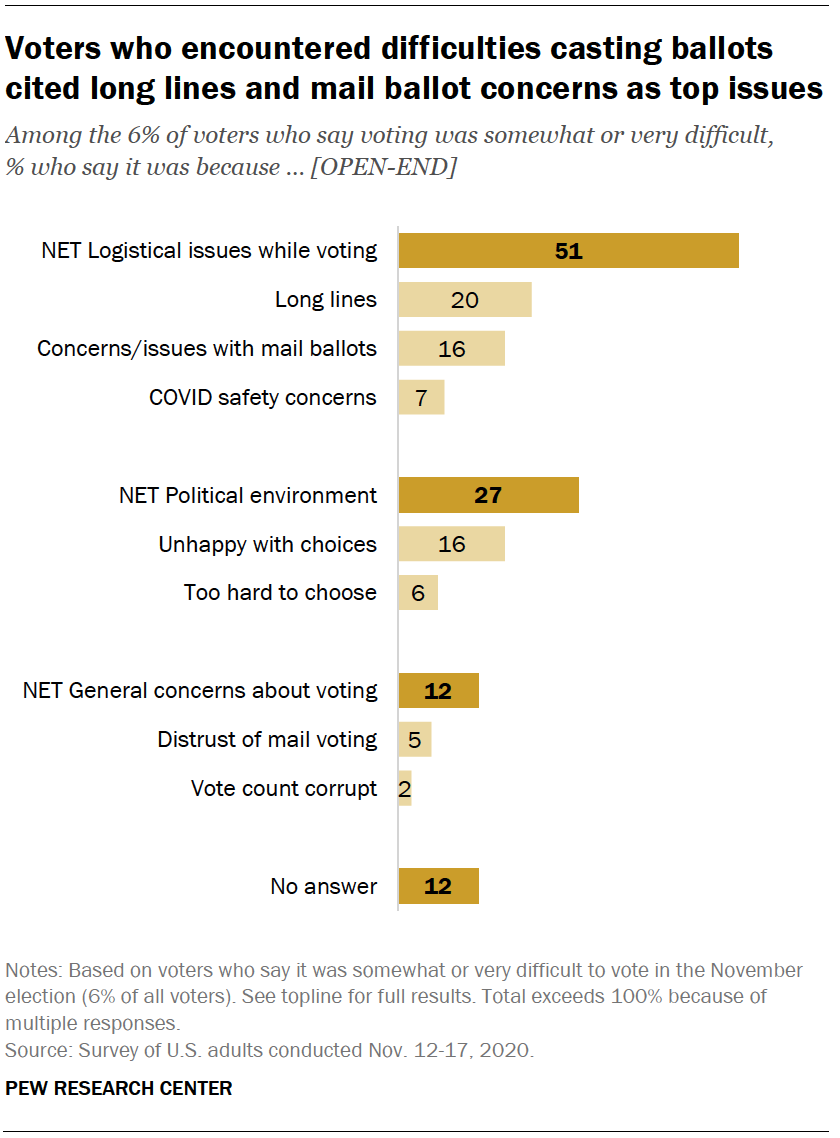
While most voters who cast ballots in the November election say voting was very or somewhat easy for them personally (94%), about 6% of voters say they encountered difficulties when casting their ballot.
For about half of these voters (51%), logistical issues like long lines or safety concerns amid the coronavirus pandemic made voting difficult. One-in-five pointed to long voting lines, and many cited unusually long wait times at polling places. One 58-year-old woman voter said, “I had to stand in the cold and rain for approximately an hour and a half. Never had to stand in line for more than 10-15 minutes inside before.”
For 16% of these voters, issues with submitting absentee or mail ballots made voting difficult. While some pointed to confusion about rules and requirements surrounding vote by mail, others mentioned delays in receiving or tracking their mail ballots in time. A 26-year-old man said, “I requested a mail in ballot, didn’t receive it, contacted my county and they said to wait 10 more business days. I contacted them again, then they finally sent a new one to me the week before the election. I made the choice to drop it off rather than mail it in because it was so close to Election Day.”
Some voters also noted that safety concerns about voting during the pandemic led to hurdles while making voting plans. One woman noted, “People in my family tested positive for COVID-19 on October 26, so instead of voting in person, we had to request a mail in ballot at the last minute.”
Nearly three-in-ten of those who say that voting was difficult say it is because they could not decide who to vote for – or did not like any of their choices in candidate: 16% say they were unhappy with their choices while 6% say they could not make up their mind about who to vote for.
About one-in-ten cited general concerns and suspicions about the voting system in general. This includes uncertainty about the vote counting process as a whole or concerns that states were tampering with the voting process, as well as specific concerns about more widespread use of mail-in voting. As one 60-year-old man put it, “I didn’t like mail-in ballots. It encourages voter fraud.”
Convenience was top factor in voters’ decisions about which way to vote
Nearly two-thirds of voters (66%) say that convenience was a major reason why they chose to vote in person on Election Day, in person before Election Day, or by mail or absentee ballot. Another 15% say that this was a minor reason for voting the way they did, while 19% say that this was not a reason.
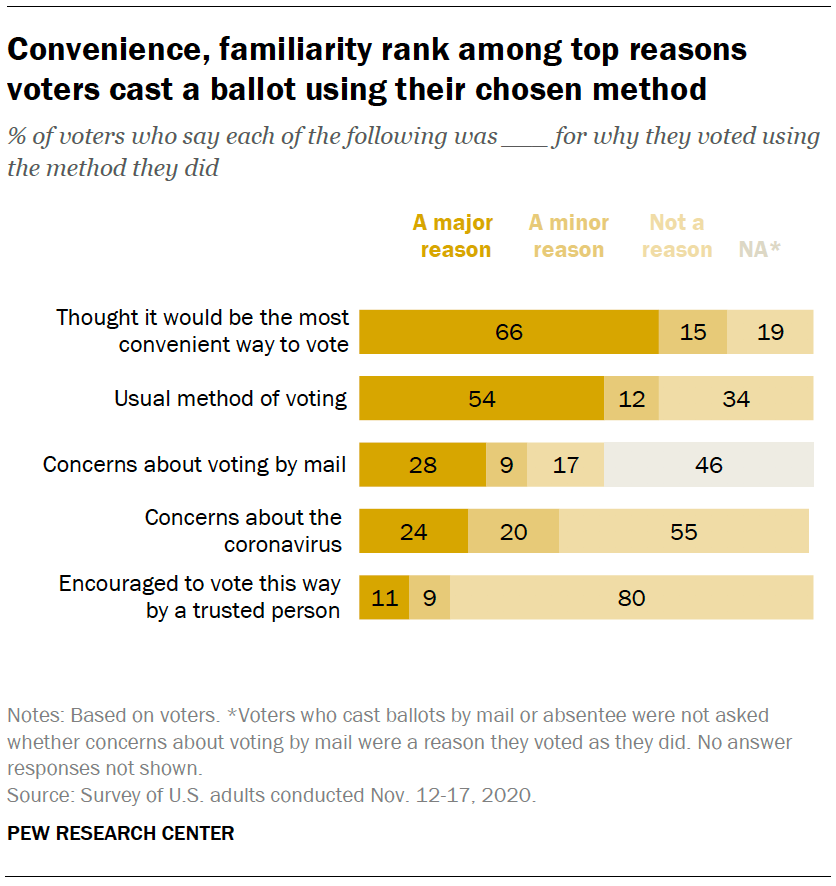
Just over half of voters (54%) say that voting the way they usually do was a major reason for their choice of method, and about one-in-ten (12%) say this was a minor reason.
Smaller shares of voters say that concerns about voting by mail (28%) or concerns about catching or spreading the coronavirus (24%) were major reasons why they voted as they did. And despite widespread expectations earlier this year that the pandemic would disrupt the November election, a majority of voters (55%) say that concerns about the coronavirus were not a factor in their decision about how to cast their ballot.
Just two-in-ten voters say that being encouraged to vote a certain way by someone they trust was either a major reason (11%) or a minor reason (9%) for the vote method they chose.
Those who voted using different methods this November point to somewhat different reasons for doing so. Among voters who voted at a polling place on Election Day, 76% say that a major reason for doing so was that they usually vote that way. In-person early voters are 19 percentage points less likely to say that this was a major reason for voting the way they did, and absentee or mail-in voters are 36 points less likely to say this.
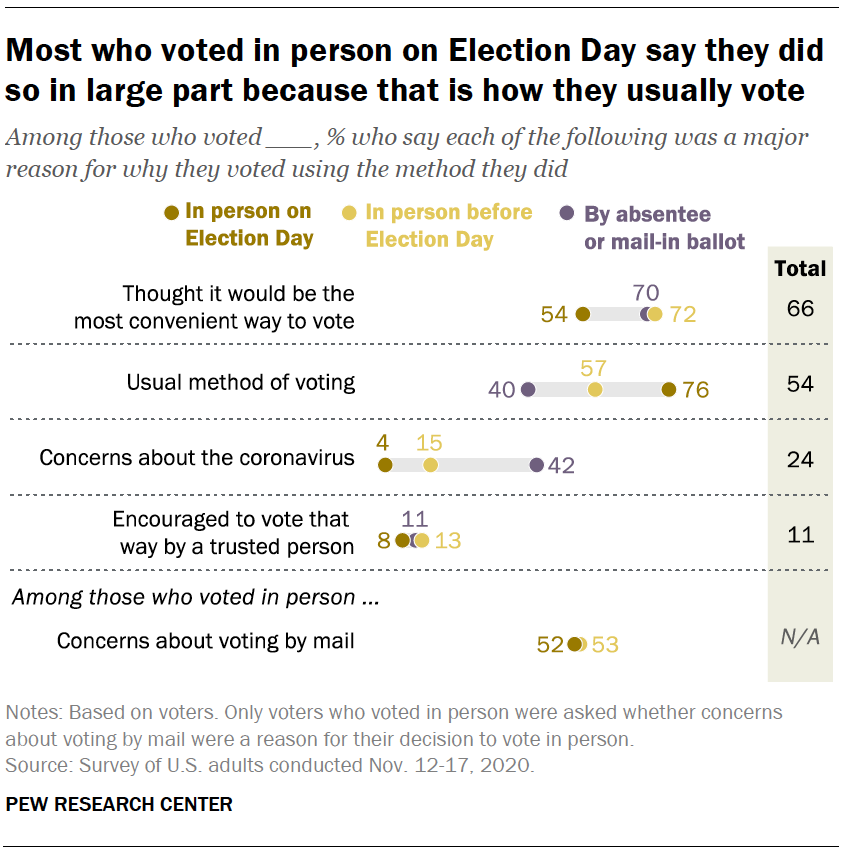
Seven-in-ten mail voters (70%) and a similar share of in-person early voters (72%) say convenience was a major reason they voted the way they did. A much narrower majority (54%) of in-person Election Day voters cited convenience as a major reason for doing so.
About half of in-person voters, (53% among in-person early voters, 52% among in-person Election Day voters) say that a major reason for voting in person was their concerns about voting by mail.
About four-in-ten mail voters (42%) cite concerns about catching or spreading the coronavirus as a major reason for voting by absentee or mail-in ballot. Just 15% of in-person early voters and 4% of in-person Election Day voters say that concerns about the coronavirus were a major reason why they voted using the method they chose.
Similar shares of in-person early voters (13%), mail voters (11%) and in-person Election Day voters (8%) say that encouragement from a person they trusted was a major reason for choosing to vote as they did.
Among in-person voters, 68% of those who voted for Trump say that concerns about voting by mail were a major reason why they voted in person. By comparison, a far smaller share of in-person Biden voters (32% ) cite this as a major reason why they voted in person.
This gap is somewhat larger among in-person Election Day voters than among in-person early voters. Among early in-person voters, Trump voters are 32 percentage points more likely than Biden voters to say concerns about voting by mail were a major reason for voting as they did. Among in-person Election Day voters, Trump voters are 42 points more likely than Biden voters to say this.
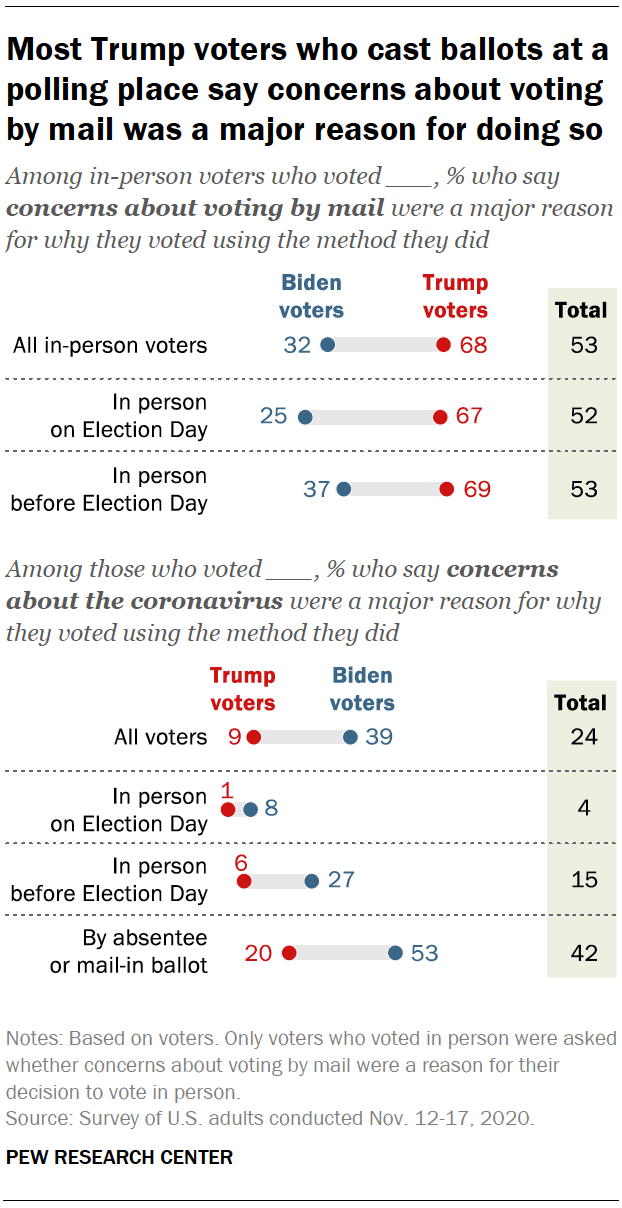
By comparison, Biden voters are more likely than Trump voters to say that concerns about the coronavirus were a major reason for voting as they did. Overall, 39% of Biden voters cited this as a major reason, compared with just 9% of Trump voters.
About half of Biden voters who voted absentee or by mail (53%) say that concerns about the coronavirus were a major reason they voted by mail, while just 20% of Trump voters who voted this way cited this as a major reason why.
About a quarter of Biden voters who voted in person before Election Day (27%) also pointed to COVID-19 concerns as a major reason for doing so, while just 6% of in person Trump early voters said the same. Few Biden Election Day voters (8%) and almost no Trump Election Day voters (1%) considered concerns about the pandemic as a major reason for voting the way they did.
Researching voting methods, checking registration, tracking wait times and absentee ballots
Biden voters are more likely than Trump voters to say they took a variety of steps to ensure they would be able to cast a ballot in the days and weeks leading up to Election Day. Nearly half of voters (48%) say they checked their voter registration status prior to the election – including 56% of Biden voters and 40% of Trump voters. And a majority of Biden voters (54%) also say they researched their options for how to vote in person or by mail this year, compared with 32% of Trump voters.
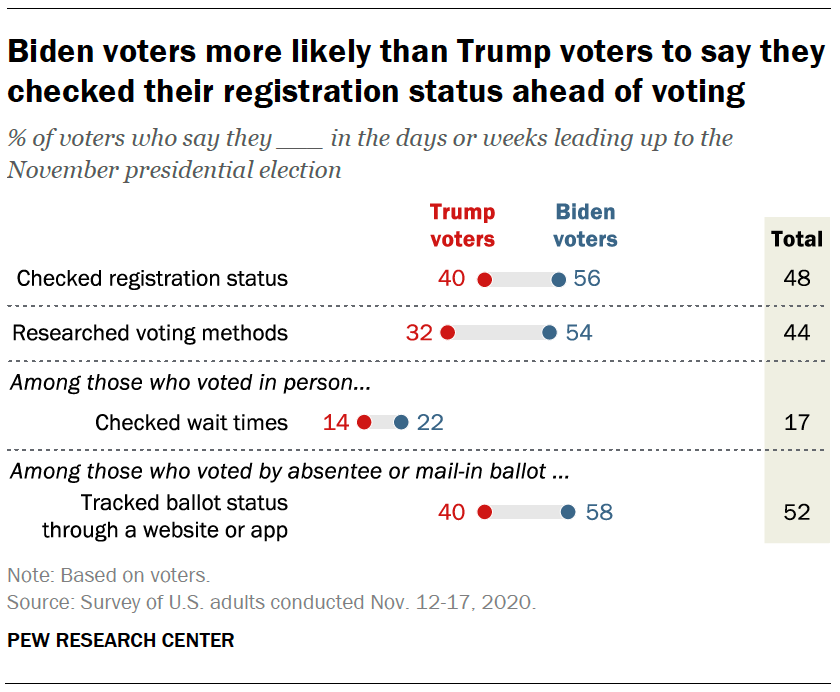
Among those who voted in person in the November election, 17% say they checked wait times at an in-person polling place before going to vote: 22% of Biden voters and 14% of Trump voters say they did this.
About half of absentee or mail-in ballot voters (52%) say they tracked their ballot’s status through a website or app: Nearly six-in-ten Biden voters (58%) say they did this, compared with 40% of Trump voters.
Black voters, Hispanic voters and Asian voters are somewhat more likely than White voters to say they checked their registration status, though these differences are closely related to levels of support for the two candidates within different racial and ethnic groups.
About six-in-ten Black (57%), Hispanic (61%) and Asian (63%) voters say they checked their registration status in the days and weeks prior to voting; a smaller share (44%) of White voters report having done this. And among in-person voters, Hispanic (30%) and Black (23%) voters are both more likely than White voters (15%) to say they checked the wait time at a polling place before going to vote.
Younger voters and those with more years of formal education are also more likely to say they took several of these steps than older voters or those with fewer years of education, respectively.
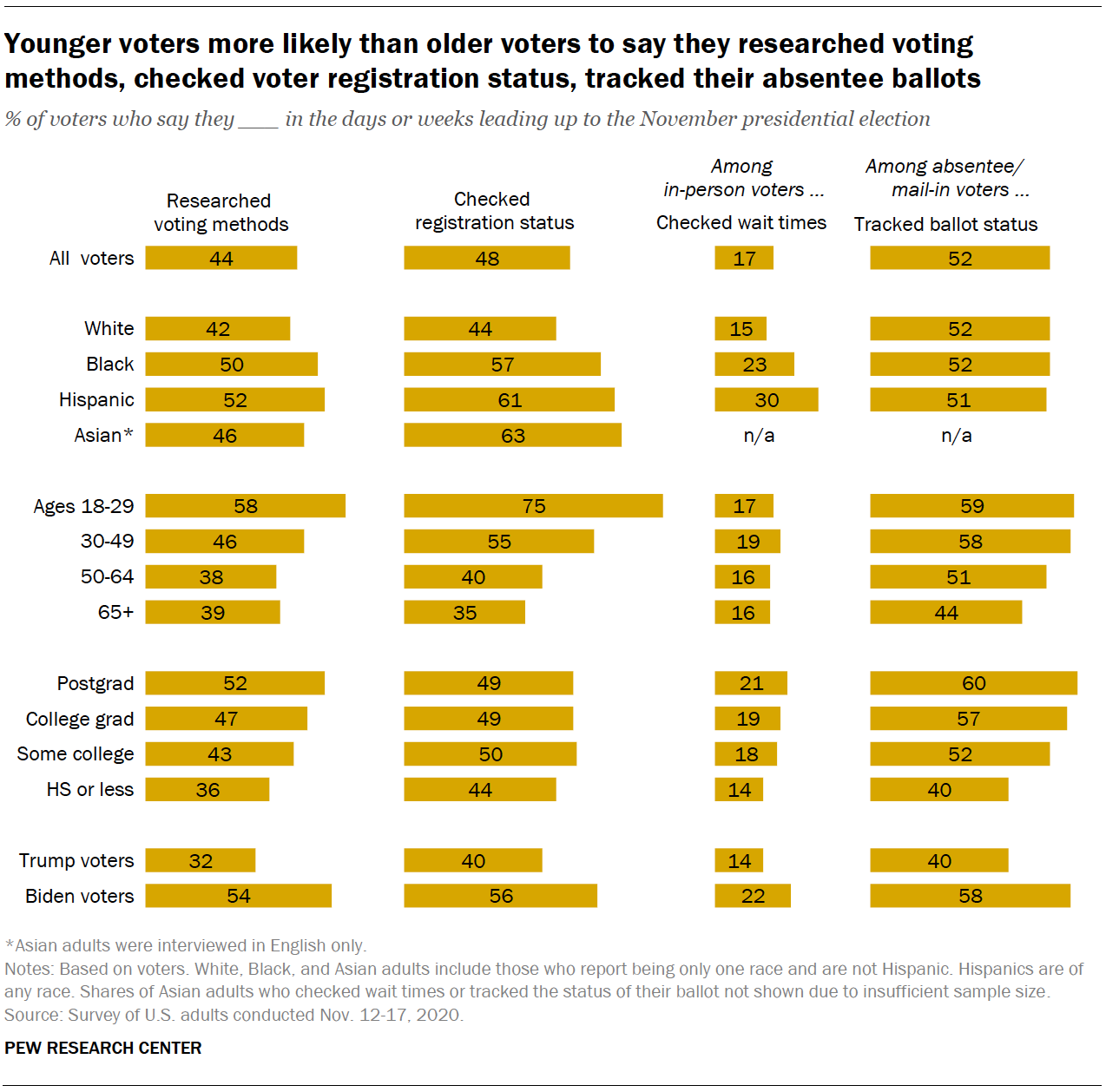
Three-quarters of voters ages 18 to 29 say they checked their voter registration status in the days or weeks leading up to the election, compared with 55% of voters ages 30 to 49, 40% of those 50 to 64 and 35% of those 65 and older. A majority of voters ages 18 to 29 (58%) say they researched their options for voting, compared with 46% of 30 to 49 year-olds and 39% of those 50 and older. And 58% of mail voters under 50 tracked their ballot’s status online while 51% of those ages 50 to 64 and 44% of those 65 years-old or older say they did the same.
Voters with a college degree are more likely to say they researched their options for voting than those without a degree (49% vs. 40%). And among mail voters, nearly six-in-ten college graduates (58%) reported tracking their ballot online, compared with 46% of those without a degree.




